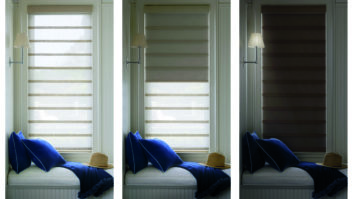A few Saturdays ago Audio Advice majority owner and president, Leon Shaw, received an irate phone call from a customer who had purchased a multi-room system from the Raleigh, North Carolina-based A/V dealer and suddenly found that his basement sump pump was on the fritz. He was sure that it something one of Shaw’s A/V installers had done and he wanted to “talk to the owner, because [he was] as mad as he could be.”
Shaw did what any wise “customer service representative” would do and calmly listened to his upset client’s complaints, assuring him that the problem would be solved one way or another.
“I called the lead installer on the job and, like I assumed, he said that he and his crew had been nowhere near the sump pump during their installation. Nonetheless, he said that he would drop by the customer’s house right away and see what he could do.”
The lead installer, who also happens to be a certified electrician, arrived at the customer’s house and quickly was able to recognize and fix the sump pump problem, though it had nothing to do with his earlier A/V work. Three weeks later that seemingly contrite customer spent an additional $50,000 on a new home theater system for his home.
The Hero Grid
Shaw makes it a point to share true success stories like the one about the sump pump to demonstrate what he calls, “the hero grid concept.” Borrowed from lessons learned from management courses taught by The Walt Disney Company, the hero grid involves seeing all problems as opportunities to gain a customer for life. The theory states that a customer who has a problem that you can solve efficiently and effectively is more likely to be a repeat customer. In the example above, even though the problem was not caused by Audio Advice, it was a big deal to the customer and relatively easy for Shaw and his team to solve.
Customer service is one of Shaw’s true passions in business. Based on information gleaned from his two Disney courses on customer service and leadership, Shaw continually trains his employees on “blowing customers away” with great service.
“There is required reading on customer service that employees have to do when they work here,” Shaw said. “I constantly train them on knowing how to react to certain situations.”
Almost every week Shaw also publishes what he calls, “The Audio Advice Magic Newsletter,” where the 26-year industry veteran relates stories of “magic moments” that occur on a daily basis between his employees and their 11,000 active customers. Stories like the one about the sump pump, will appear, and so do the more “staged” moments like when salesmen discretely learn their new customers’ hobbies and then present gift baskets containing items related to those hobbies, upon completion of an installation.
An Evolving Operation
Back in 1978 Shaw couldn’t escape his passion for stereo gear, despite having graduated with a degree in economics from Wake Forest University. After a six-month stint as a salesman for Sam Goody, the 23-year-old founded Audio Advice, along with partner Ira Dorne, whom Shaw bought out in 1984. Audio Advice started out selling 2-channel, high-end audio equipment, then eventually picked up the first Sonance in-wall speakers and began offering installation services in the ’80s.
“I like ‘the toys,’ and that’s how we got into the other product areas,” Shaw explained. “I was the one who pushed us to get into lighting control and home automation, because I’m interested in those areas.”
Audio Advice continued to grow over the years, and like many other firms, has developed a more sophisticated installation operation along the way. Currently Shaw, along with vice president and minority owner, Randy Cribb, manage about 42 employees and recorded just under $10 million in sales last year. The company, housed in a new 18,000-square foot building owned by Shaw, manages to balance its retail and custom operations through a very specific plan developed over the past three years.
“At first we tried to make retail and custom one and the same,” Shaw explained. “Anyone on the retail floor had the ability to sell anything custom. What that did, however, was to make the elaborate custom jobs sold by the retail people not turn out so well.”
Then two years ago Shaw and his managers “divided” the store in two, defining certain employees as outside sales people and others as retail sales people. “They can sell home theater systems but if it goes beyond that they have turn the other part of the job to an outside sales person,” Shaw explained.
Shaw has been reluctant to jettison his retail operation, because he said, retail is still more profitable for him. Plus, he enjoys the merchandising aspect of the business too much to let it go.
“I really enjoy creating store displays, holding special sales events and making the store a really fun, Disney World-type place. I would never want to get out of it, because it’s a very fun part of the business if you’ve got it going well,” Shaw said.
Despite the recent struggles of the U.S. economy, Audio Advice has not experienced a slow down in its retail operation. “I think if you stay in contact with your customers, you’re in their mind, and I think that in slower economic times people still want to enjoy their music and their movies,” Shaw explained.
Audio Advice’s new facility plays well to Shaw’s passion for Disney-style showmanship. The store’s 7,000-square-foot retail showroom is designed to focus on the interactive products of the industry and is meant to be very “hands-on” for its customers.
“People can go up and play with a Crestron Isys on the wall or touch screens in our theaters,” Shaw explained. “It’s fairly interactive and it’s evolving.”
The rest of the facility contains office, service and warehousing space, and an adjacent 3,000-square-foot space is Audio Advice’s installation lab, where the custom guys pre-build all large systems, tests them and wires them up in Middle Atlantic racks.
“The custom part I think is just more about hiring the right people to be in the right places and putting systems in place to make things run smoother for them,” Shaw said of his installation operation. Building those “systems” is another area in which Shaw takes great pride. The systems that he has built have also enabled Shaw to step back and manage his company from the outside looking in.
“I was at a seminar a few years ago, and it was pointed out the distinction between working on your business and working in your business. I’ve been trying to only work on my business the last few years and do things that affect everyone,” he explained.
Shaw’s transformation is best illustrated by the fact that up until a few years ago he was the number-one salesperson at Audio Advice, and now he doesn’t sell anything.
“The hardest part is taking your client base and turning them over to other people,” he said. “I miss the sales floor. I liked being out there, but I also like the challenge of coming up with various systems the help us run the company more efficiently.”
Much of Shaw’s work has centered on systems within Filemaker Pro, a relational database software program. “Our whole installation department and scheduling runs on those databases,” he said. “Many years ago I thought it would be really neat to be a manufacturer and to figure out how to produce things efficiently. That’s really what we’re becoming–more like a manufacturer. We manufacture these custom systems, and they require many parts that are a great challenge to figure out.”
Shaw’s goal is to make information easily available to everyone in the company and in turn to save as much time (and money) as possible.
“The systems make everyone more efficient,” he said. “We try to document as much as possible. By using a relational database, you can pull up all project history, easily. If someone is going out to a house, they can just look back and see everything that was done previously.
“You just have to measure what you do and know how to analyze your measurements,” Shaw continued. “If you know you’ve got a problem, and you don’t know what’s causing it, there’s no way to fix. You can’t just keep putting out the same fire. You have to know what’s causing it.”
The Latest Challenge
Most recently, Shaw has been working on a method to help make his custom installation operation more profitable by delivering and billing for more labor. “I think a lot of retailers who got into custom used to deliver the system and set it up for free,” Shaw noted. “We’ve gotten out of that mode, because it really is a very valuable service that we offer, and has should have a definite value.
I think the bigger you get the more you realize that you’ve got to charge for your services. It’s easier to give stuff away when your payroll is not as large.”
Shaw says that he focuses on increasing his installation department’s profitability, because eventually products will become such commodities that custom installation companies will be forced to make money on labor alone, or go out of business instead.
Internally, Audio Advice tracks the installation and retail departments as separate companies. This approach allows Shaw to determine the success or failure of, say, his custom installation department’s labor rates.
“We look at installation to see if they would survive on their labor billings alone,” he explained. “What we’ve found is that they’re still just barely not turning a profit if you consider everything. We’re billing out more labor than just the cost of employees, but if you factor in the fixed costs like the rent and the trucks, it’s still not a profitable entity on its own. It’s close, but not quite.”
Shaw’s challenges are somewhat abated by the strong support of not only his leading salesman and co-owner, Randy Cribb, but also his innovative installation manager, Kurt Sykes.
“Randy is a great sales person,” Shaw said of Cribb. “He works with the retail sales guys, training them on sales processes. And Kurt Sykes is fantastic as our installation manager. He reviews all jobs along with our head engineer, Robert Parker, and has put into place a really good way to measure installers’ abilities.” Essentially, Sykes has implemented his own certification system for his installation staff, where each employee earns Level 1, 2, 3 and Master Installer status as they improve in ability over their careers.
“We’ve defined what you need to be able to prove that you can do before you’re able to achieve a certain level,” Shaw said.
Sykes, Shaw added, also has designed a new labor estimation spreadsheet so sales people can quickly figure out what a project is going to cost on an estimated-labor basis. “We’ve gone back and looked at all of this historical data and he’s got this huge Excel spreadsheet to figure it out,” Shaw said.
Future Challenges
Though he cites constantly changing technology as one his company’s biggest challenges, Shaw works hard to maintain strong relationships with the vendors most important to his success.
“We support some manufacturers more than others,” he said. “Runco is our key front-projection partner. Lexicon and Madrigal are our high-end audio partners. B&W, Aerial and Linn would be our main speaker lines, while support both Crestron and AMX for automation, Lutron for lighting control and Sony for video components and plasmas.”
Over the years a few specific products (the “toys”) have gotten Shaw excited. Among these are Lutron’s Radio RA, AudioRequest’s audio hard-drive, both Crestron’s and AMX’s touch panels and any of the new 16 x 9 DLP projectors.
Shaw notes that he’s also a big fan of Linn gear and has always liked Lexicon’s A/V products.
Most of Audio Advice’s custom projects focus on those key brands, according to Shaw. “We don’t change brands that often at all,” he said. “We try to develop a great relationship with our vendors and only complain if they’re screwing up. Because I’m so passionate about customer service, I get really upset when I don’t get it myself. I’m the customer to them, after all.”
Eventually, however, Shaw hopes to create a whole new “brand” of his own. He envisions a time when customers ask for an “Audio Advice System,”–identifying his A/V package as the product rather than a collection of separate pieces.
“I don’t want people to say, ‘I got a Runco home theater’,” he explained. “I want them to say, ‘I got an Audio Advice home theater.’ I think we’re getting there with that as we change the way we promote what we do. If people think, ‘I want to get great home entertainment,’ we’re the name they now think of in our area. Whatever that requires us to do to keep it happening, we’ll figure out how to do it.”
Jeremy J. Glowacki is editor of Residential Systems.







